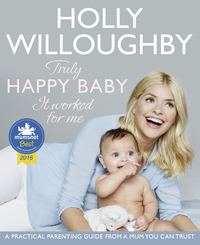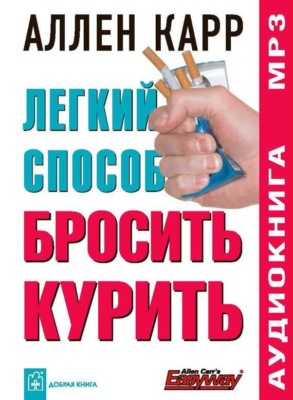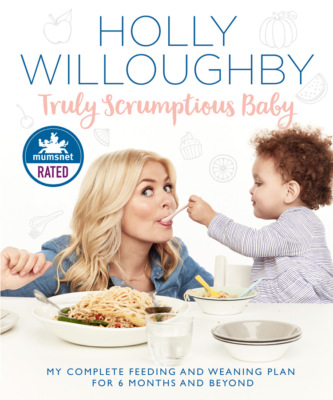Czytaj książkę: «Truly Happy Baby ... It Worked for Me: A practical parenting guide from a mum you can trust»

COPYRIGHT
Thorsons
An imprint of HarperCollinsPublishers 1 London Bridge Street London SE1 9GF
This edition published by Thorsons 2016
FIRST EDITION
Text © Holly Willoughby 2016
Photographs © Ellis Parrinder 2016 except where indicated
Cover layout design © HarperCollinsPublishers Ltd 2016
Cover photograph © Ellis Parrinder
A catalogue record of this book is available from the British Library
Holly Willoughby asserts the moral right to be identified as the author of this work
All rights reserved under International and Pan-American Copyright Conventions. By payment of the required fees, you have been granted the nonexclusive, non-transferable right to access and read the text of this e-book on screen. No part of this text may be reproduced, transmitted, downloaded, decompiled, reverse engineered, or stored in or introduced into any information storage retrieval system, in any form or by any means, whether electronic or mechanical, now known or hereinafter invented, without the express written permission of HarperCollins e-books.
While the author of this book has made every effort to ensure that the information contained in this book reflects NICE (National Institute for Health and Care Excellence) and NHS guidelines at the time of publication, medical knowledge is constantly changing and the application of it to particular circumstances depends on many factors. This book is intended as a reference volume only, not as a medical manual. The information given here is designed to help you make informed decisions about you and your baby, and it should be used to supplement rather than replace the advice of your doctor or other trained health professionals. Therefore it is recommended that a qualified medical specialist is always consulted for advice. The author and publishers cannot be held responsible for any errors and omissions that may be found in the text, or any actions that may be taken by a reader as a result of any reliance on the information contained in the text.
Find out about HarperCollins and the environment at www.harpercollins.co.uk/green
Source ISBN 9780008172527
Ebook Edition © June 2016 ISBN: 9780008172534
Version: 2016-06-24

CONTENTS
COVER
TITLE PAGE
COPYRIGHT
INTRODUCTION
 CHAPTER ONE: FEEDING
CHAPTER ONE: FEEDING
01 The need-to-knows and the know-hows
02 Milestones and routines
03 Feeding solutions
 CHAPTER TWO: SLEEPING
CHAPTER TWO: SLEEPING
01 Making the nest
02 Milestones and routines
03 Sleep solutions
 CHAPTER THREE: WELLBEING
CHAPTER THREE: WELLBEING
01 Your newborn’s wellbeing
02 Caring for your baby
03 Growth spurts and developmental milestones
 CHAPTER FOUR: LIFESTYLE
CHAPTER FOUR: LIFESTYLE
01 The serious stuff
02 Development and play
03 What to do with your days
 CHAPTER FIVE: LOOKING AFTER YOU
CHAPTER FIVE: LOOKING AFTER YOU
01 What’s going on with you?!
02 Life after having a baby
03 Support for you and your new baby
SOME EXTRA ADVICE
INDEX OF SEARCHABLE TERMS
THANK YOUS
ABOUT THE PUBLISHER

I knew I would write this book when I had my first son, Harry. I couldn’t believe how many times I thought – and indeed heard fellow parents say – ‘Why didn’t anybody tell me about this?!’ There’s no two ways about it, becoming a new mum or dad can be incredibly daunting. There’s no other job on the planet this important where you wouldn’t be given first-class training to prepare you, but as babies don’t arrive with an instruction manual, this is me passing on all the things that I found worked for me, in the hope they might help you too. I’ve been blessed with three very different babies, so whilst I don’t profess to have any official childcare qualifications (although all the advice in this book has been checked by a medical professional), I have had a lot of varied experience, coping with, and getting to know, each of my children. In this book I’ll share all the best bits I’ve learnt along the way for how to look after my family.
The best piece of advice I can give you, and which you should try and keep at the forefront of your mind, is YOU KNOW BEST! Albert Einstein himself said, ‘The only really valuable thing is intuition,’ and who are we to argue with a genius?! Listen to intuition, switch off fear. When you first have a baby, you might feel bombarded with advice from friends, family and medical professionals, and some of that advice can be conflicting. This is when you have to sift through what you’ve been told, and then listen to you. I’m going to be really honest with you throughout this book about the decisions I made for my babies and my reasons for making them, but I can’t stress enough how important it is that you go through your own thought processes, filter all the information and make the decisions that are right for you and your baby. Don’t just do things because I’m saying that’s what I did, and don’t avoid doing things because someone else tells you not to. No one knows your child better than you, and the sooner you learn to trust and follow your gut, the more empowered, confident, relaxed and happy you will become as a parent. And, remember, no parent on the planet gets it right all the time. I certainly didn’t, and more often than not the questionable decisions I made were not my own.
In this book, I’ve tried to give the best overview I can of the first year of your baby’s life. Hopefully you’ll find the more baby-led chapters such as Feeding, Sleeping and Wellbeing a really helpful but gentle guide for how to care for your baby, full of the tips that particularly worked for me. Then I’ve talked about Lifestyle and the changes for you and your new family, and what things you can do to make the transition smooth and the outcome even better than before. Lastly, I’ve tried to be as honest as I can in the Looking After You chapter, as at a time when life is so completely different, so are you, and this can feel utterly overwhelming sometimes.
It’s important to say here that this isn’t a rule book. One size most definitely doesn’t fit all when it comes to babies so you need to spend time getting to know your baby to find out what works for you both. You might have to go through ten different soothing methods before you find one your baby likes, for example, and even then it’ll probably be one you made up – see, I told you to listen to your gut! If you’re at that point where nothing seems to be working and you’re at your lowest ebb and most exhausted, try to remember that nothing lasts forever! You’ll be in a completely different place in a month or so – just hang in there.
One final thing I should stress is that new mums don’t always feel an overwhelming surge of love for their new baby when they first give birth. If that’s you, you’re in good company! Please don’t beat yourself up about it. Just make sure you look after yourself and that little baby; you’ve got plenty of time to watch the love flow in – a whole lifetime in fact!
Best of luck to you and that new little baby! Let’s go through this together … deep breath …
Love


Is it best to breastfeed rather than bottle-feed and will it come naturally?
Your new baby’s finally here, and she’s hungry! How you decide to feed her is ultimately your choice, because the method that’s best is quite simply the one that works for you both. Breastfeeding is often described as the most natural thing in the world, but at times it can be the hardest thing to do. There’s a real art to it and it’s a 50/50 deal – 50 per cent you and 50 per cent your baby.
I put Harry on the breast straight away and went on to feed him successfully. However, a few hours after he was born the midwife asked me whether I’d like to top him up with a bottle so we could both get some sleep. I did this without hesitation and never had any issues putting him back on the breast. Belle arrived nearly six weeks prematurely and, despite being given drugs to slow my labour, I was expressing breast milk before she was even born! With my little reflux baby, Chester, I soon realised that sometimes no matter how hard you try, it doesn’t work out. So my experience is proof that you just never know how it’s going to work for you.
There’s so much to consider with feeding and lots of conflicting advice! Is breast always best? Which formula should you go for? When should you wean? I hope you’ll find some answers in this section that resonate with you, but ultimately – feed your baby the way you want to!

01
The need-to-knows and the know-hows Here I’ve tried to give you an overview of all the paraphernalia you’ll need to feed your baby – whether you’re breastfeeding or bottle-feeding, or, like me, doing a bit of both. When you’re trying to breastfeed, establishing your milk supply and feeding successfully can be a bit of a minefield. This section gives you a heads up on what to expect, how things change and some tips for improving your milk supply.
The only thing I would say right now, before you drive yourself crazy, is that breastfeeding doesn’t always work. Even with the best will in the world and the most iron-clad determination (that I had with Chester), sometimes it’s just not meant to be and you’ll end up turning to formula – which is fine! All you can do is research, try everything to make it work and then see how you go. Good luck!
BREAST V. BOTTLE
Before embarking on this age-old debate, I want to stress that however you decide to feed your baby is right. If you’re a milking machine from day dot, then lucky you! If you want to put your baby straight onto formula, then good for you. If you’re hell-bent on breastfeeding, but hitting wall after wall, be at peace with giving formula! As long as you’re comfortable with your decision, it’s right. Feeling guilty and stressed during the first weeks of your baby’s life will be far more detrimental. You’ll have heard the pros and cons of both throughout your pregnancy. So, instead, I’m giving you the breastfeeding ‘headlines’ that convinced me to give it a go:
• Early bonding. Take it from me, when your baby opens her eyes and gazes back at you whilst feeding, you will feel an intensity like you’ve never known.
• Your antibodies are carried through your milk, so how could I not at least try to pass that protection on to my baby? Studies have also shown that breastfeeding has health benefits for you too.
• Breast milk evolves as your baby grows, to suit her specific nutritional needs. Although formula does contain nutrients, it stays exactly the same. Only breast milk is bespoke for your baby.
• For the lazy mum in me, breastfeeding is convenient. It’s available for your baby whenever your baby needs it, there’s no washing up, no sterilising and no warming a bottle in the middle of the night. So, in actual fact, for the lazy mum, once you’ve got it right, this could be for you!
I attempted to breastfeed all three of my babies, and I can say with brutal honesty that each time the first two weeks were very challenging. But I never give up without a fight, and with Harry and Belle I’m happy to say I was very successful. So you can imagine my frustration when with Chester no amount of grit and determination overcame the problems! I opted for bottle-feeding him expressed milk (see here), and eventually switched him to formula. That worked for me, so make sure you find what works for you too.
THE LOW-DOWN: BREASTFEEDING

The golden nectar – colostrum …
Before your breast milk comes in (at some point during the first two weeks after birth), your breasts produce colostrum, which is pure golden nectar to your baby. Colostrum looks a little bit like clear honey and is jam-packed with goodness for your newborn. It doesn’t spurt out like milk; it’s more of a slow trickle. I have to say it’s hard to get your head round the fact that those few droplets are enough to stop your baby from being hungry or thirsty. Colostrum is really potent stuff, fulfilling all your baby’s needs, both nutritional and functional – it’s low in fats, and high in carbohydrates, protein and antibodies to help keep your baby healthy. It helps to protect your baby against infection, and also with that all-important first bowel movement – another reason new mums are really encouraged to give breastfeeding a go. Colostrum may come in before your labour even starts and, if it does, it’s nothing to worry about. If anything it just means that everything is working as it should be and that your baby will be here soon! If this does happen, pop a breast pad into your bra to stop any embarrassing leaks! Breast pads will soon become your new best friend – the times I reached into my handbag for a tissue and ended up with a breast pad stuck to my palm!
Breast-milk production …
To produce good breast milk, you have to have high levels of a hormone called oxytocin – this is often referred to as the love hormone because it’s triggered when you meet the love of your life! Oxytocin is needed for the letdown reflex to trigger your milk flow and can be released simply by looking at your baby, hearing another baby cry, or even just feeling warm and fuzzy. I can remember feeding Chester with the telly on in the background, and the John Lewis Christmas advert came on, the one with Monty the penguin – and I nearly flooded the place!
To have all this lovely oxytocin in your body, you have to be in love with your baby – tick! – but you also need to be well rested, well fed, not too tired and really calm and relaxed. The chances are you’ll be struggling with these bits! So the best piece of advice I can give is to try to look after yourself as best you can as one thing impacts the other. If looking after yourself and your mental state means topping a screaming baby up with a bottle of formula so you can get some sleep and give your milk half a chance of coming in, then do it! If, however, you do make that decision but want ultimately to breastfeed, you should try to express off that missed breastfeed to establish your milk supply. Everyone’s milk production is different. I know I had three quite different experiences with my babies.

Breastfeeding bracelets If you wear a bracelet on the arm corresponding to the breast you last fed from (so your right arm if you fed from your right breast), you’ll never forget which side to use for the next feed. There are lots of lovely mummy bracelets available, or any old hair band will do – just make sure it’s not too tight!

© Shutterstock.com
What to eat whilst breastfeeding …
Your diet It’s often difficult to keep track of mealtimes in the early weeks when you’re so busy with your baby, but try not to skip meals – you need to be well nourished to produce a healthy milk supply. Now is not the time to eat less to lose weight – the old adage of making sure you get your five portions of fruit and veg a day, and a good balance of carbohydrates, protein and dairy foods, is never more important. Breastfeeding can make you extra-hungry so try to reach for a healthy snack, such as a yoghurt or some wholegrain toast, rather than the biscuit tin. These are some other foods that can help improve the quantity and quality of the milk you are producing:
• Oatmeal
• Green leafy vegetables, e.g. spinach
• Oily fish
• Lentils and pulses
• Brown rice
• Nuts and dried fruit
• Fennel and fenugreek seeds
Your baby’s tastebuds How a baby reacts to your diet can vary and, whilst it’s good for the baby to experience different tastes and smells through your breast milk, it’s a case of trial and error. Some mums don’t think twice about eating spicy foods whilst breastfeeding, as it has little or no effect on the baby, but others might find their baby really struggles to digest the milk. Some babies might show signs of lactose intolerance through mum eating a lot of dairy. If you think your baby is suffering in some way (diarrhoea, eczema, bloating, constipation, to name a few symptoms), try eliminating certain foods from your diet to see if there’s an improvement. Don’t overdo it on caffeine and alcohol as both can affect your baby when passed on via your milk supply.

Water I always made sure I had a large bottle of water to hand before I sat down to feed, as I’d quickly become really thirsty. It’s also essential to stay hydrated when you’re breastfeeding as it’s very important for breast-milk production.

courtesy of the author
Cookies … and milk! …
A friend gave me this recipe for lactation cookies. I don’t know whether it was just a placebo, but I definitely felt they made a big difference to my milk production. The magic active ingredients are brewer’s yeast powder (which you can buy from all good health stores), flaxseed and some good-quality rolled oats. I’ve added raisins, but experiment substituting (or adding) things you love. Good flavour combinations are cranberries and white chocolate chips, and dates and walnuts.
The magic ingredients
—
2 tbsp milled flaxseed
220g unsalted butter, softened
310g golden caster sugar
2 eggs
1 tsp vanilla extract or ground cinnamon
3 tbsp brewer’s yeast powder
1 tsp salt
280g self-raising flour
130g rolled oats
150g raisins
—
Makes about 18 cookies
1. Preheat oven to 180°C/350°F/Gas mark 4 and line a baking sheet with greaseproof paper.
2. Mix the flaxseed and 4 tablespoons of water together in a mug and leave for about 5 minutes.
3. In a large bowl, beat together the butter and caster sugar (or use a food mixer). Add the eggs and beat in, followed by the vanilla extract or cinnamon and the flaxseed mixture.
4. In a separate bowl, sift in the brewer’s yeast, salt and self-raising flour and mix together. Add this to the wet ingredients and mix well.
5. Stir in the oats and raisins (or whatever extra ingredients you’ve chosen), so that they’re evenly dispersed through the dough. If you’re using an electric mixer, you should do this part manually with a spoon.
6. Take a lump of dough (roughly a heaped dessertspoon) and, with your hands, roll into a ball. Place on the baking sheet, flattening the ball slightly with the back of a wooden spoon.
7. Repeat with the rest of the mixture, leaving a decent-size gap between the cookies because they spread as they cook. I find six balls in two rows of three work best in terms of them not sticking together.
8. Bake for 12–15 minutes, until golden. My oven produces perfect results after 14 minutes, so it’s trial and error!
9. Remove from the oven and set aside for 5-10 minutes to firm up. Then transfer to a wire rack to cool completely, or dig in whilst still warm!
Switching to formula …
You’ll have been told that the official guidelines are to feed your baby solely on breast milk for the first six months. But sometimes you may decide that breastfeeding either isn’t for you or isn’t for your baby, and the reasons for this are broad and wide. Whatever your reason, you’ve got one and that’s good enough for me – and it should be good enough for anybody else too (family members, midwives, health visitors, fellow mums!). Some possible reasons for calling it a day on breastfeeding are:
• You’re not making enough milk to satisfy your baby so she’s not gaining weight.
• You’ve been ill and, whether or not that ended up in a hospital stay, your milk production has lost momentum.
• You’ve had mastitis (painful engorging of the breasts – see here), which can sometimes lead to your milk supply drying up.
• You’re simply too tired or overwhelmed by the breastfeeding schedule.
If you’ve reached this point and are feeling dreadful about it, ask yourself how many people you know who weren’t breastfed. Do you think it’s had a detrimental effect on their lives? The answer is likely to be … NO! So why do we put so much pressure on ourselves? A contented baby and equally contented mummy is the most important thing, so be at peace!

HOW TO: BREASTFEED
Getting it ‘right’ …
It amazes me how newborns put onto the breast immediately try to latch on. It’s as if they know more than you and are saying, ‘Come on, Mum! I know how to do this!’ Did you know that your newborn just happens to be able to see as far as the distance from your nipple to your nose, so as she is feeding your face is the clearest thing to her? And that your nipples are expanded and darkened during early motherhood so that your baby can find them easily? Mother Nature really does think of everything!
To be able to feed your baby is a special bond, but there are plenty of other opportunities to bond – don’t worry!
But, remember, no two babies are the same. You might be a milking machine for your first baby and then a complete novice with the second. Or you and your baby just might never meet in the middle. The bottom line with breastfeeding is if your baby is happy and gaining weight, you’re doing it right.
To begin with, there are many things to try: where and what time to breastfeed, how to position yourself and the baby, how the baby latches on. You may be told that if you’re doing it properly, breastfeeding won’t hurt. Rubbish! A good friend of mine is a maternity and breastfeeding expert. Now she has her own children she feels insanely guilty that she told so many mums that it shouldn’t hurt. It wasn’t until she attempted to put all her advice into practice that she realised she didn’t have the answers after all! Unfortunately it’s always likely to hurt for the first couple of weeks, but once you’ve got the hang of it, it should get easier. If it doesn’t, seek advice and help from your health visitor, midwife or GP. I’ve also covered breastfeeding issues and resolutions in the last section of this chapter (see pages here).
Getting your baby to ‘latch’ …
Just as every baby is different, every latch is different, but here are some pointers to help you. If your baby keeps coming off the breast or she is uncomfortable, simply try putting her on again. It does take practice.
Positioning Make sure you are comfortable (see here) and that your baby’s mouth is level with your nipple. She should be close enough to reach the nipple without straining for it, with her head and body in a straight line.
Latching To encourage your baby to open her mouth nice and wide, touch your nipple to her lips and mouth so that she can taste the milk. Then as soon as she opens her mouth, move your baby’s head up and over the nipple, pushing as much of the areola in as possible. Free the bottom lip if it gets dragged in slightly to perfect the seal around the breast. The tip of the nipple should be deep inside her mouth or those strong little gums will hurt it. Don’t worry about your baby not being able to breathe whilst feeding. As long as you’re gently supporting her neck and shoulders and not clamping her head against your breast, she will pull away if she needs to. A good latch will mean your baby is positioned really closely against your breast.
Shaping Us mummies are all different shapes and sizes and babies only have little mouths, so you may have to forge out the perfect mouthful. To do this, hold your breast from underneath and use your thumb and fingers like pincers either side to squeeze the nipple and areola into a shape that’s easier for your baby to take.
Checking the latch If your baby is latched on correctly, after a few rapid sucks she should revert to slow, rhythmic sucking, which you can watch with great satisfaction if you look at her neck as she gulps the milk down.
Seeking help Once you get the latch right, you’ll never look back. If you are struggling, seek help from your health visitor or a breastfeeding organisation. Like I said before, breastfeeding is an art – sadly, so many women give up in those early months due to lack of advice.
Breastfeeding positions to try …
First, make sure you have plenty of cushions around you for comfort and support. Feeding can take a while, especially in these early days, so it’s important you have everything you need to hand.
Try to get your baby to empty one breast before offering the second. When she is really small, she probably won’t take the second, but if you’ve stuck to one breast, you can be more sure your baby has completed the milk cycle and taken all the nutrients she needs out of a feed. For the first few minutes on the breast your baby suckles foremilk, which is the thinner, thirst-quenching stuff, before she is hit with the fattier, richer hindmilk.
Darmowy fragment się skończył.












